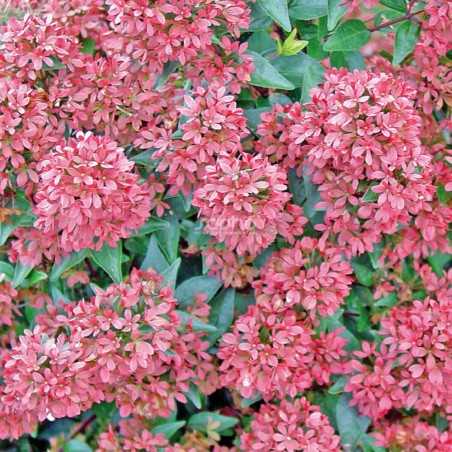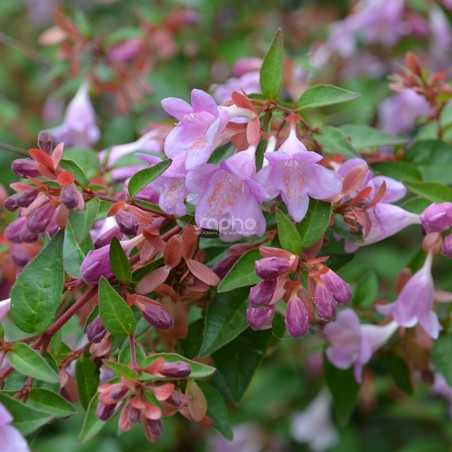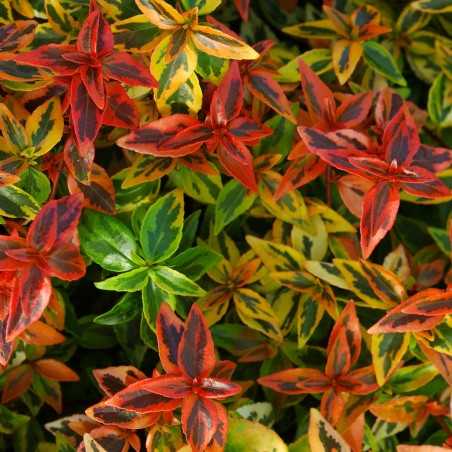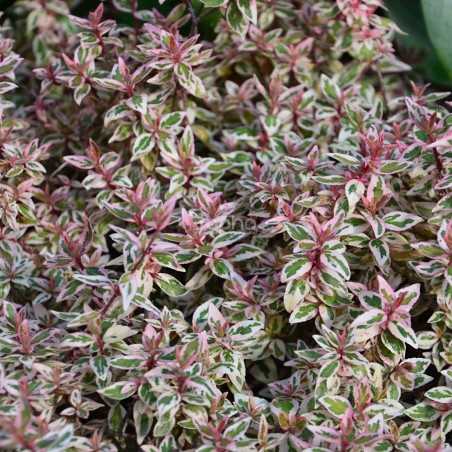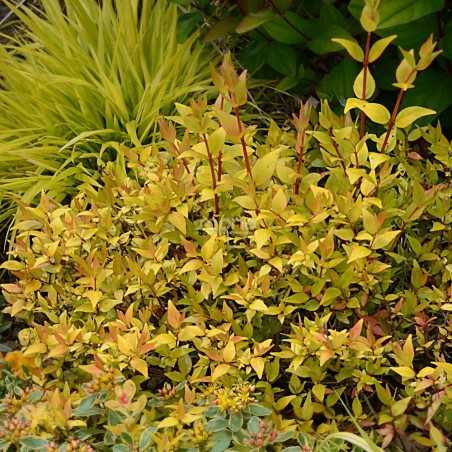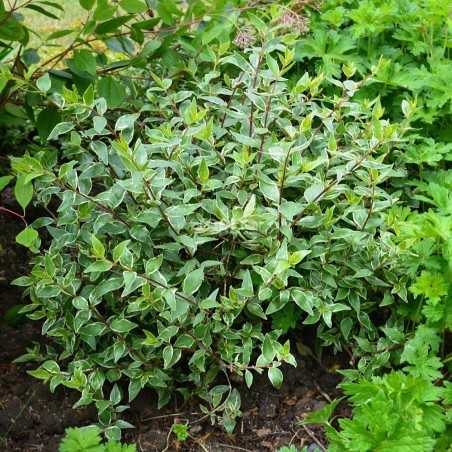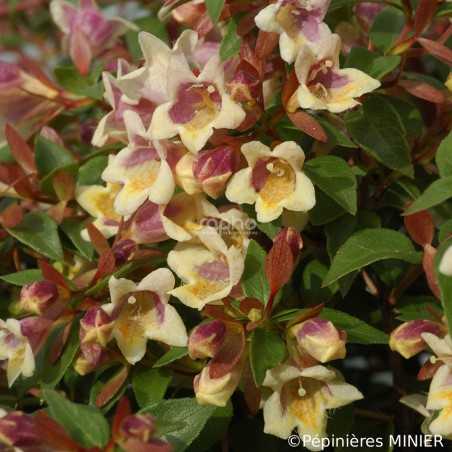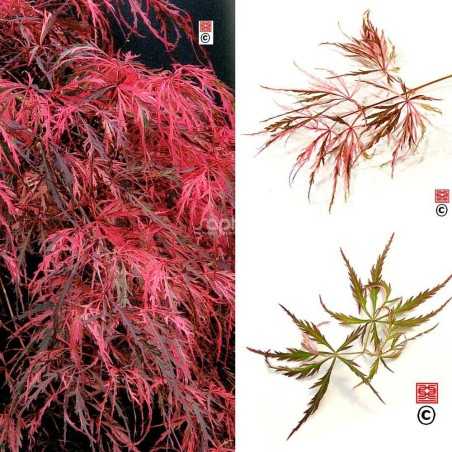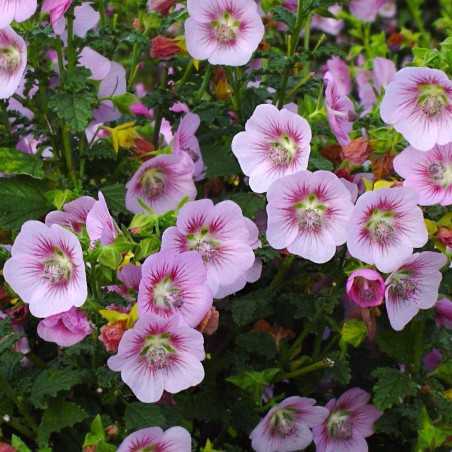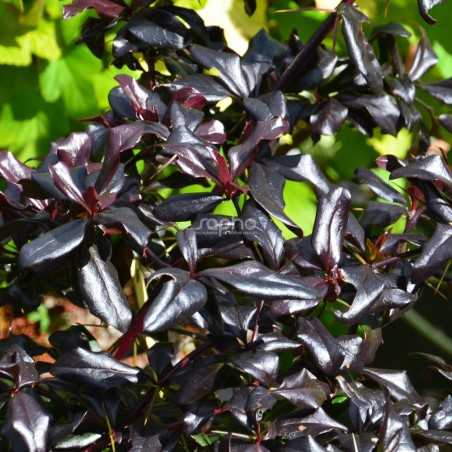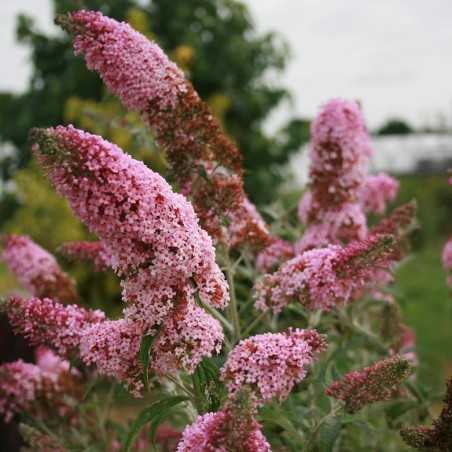An abundant flowering and double impact through its flamboyant raspberry sepals
A hybrid between 'Edward Goucher' and Abelia chinensis, 'Raspberry Profusion' is remarkable for its early flowering and double effect. The plant is covered with a profusion of large clusters of highly fragrant pink flowers with flamboyant raspberry sepals.
Flowering begins in May, peaks in June and continues through summer and autumn. As the flowers fall, the sepals hold on, prolonging the interest of the bloom, providing attractive color until late autumn.
The pretty, glossy green foliage is virtually deciduous in winter. A small shrub with a compact, spreading, domed habit, it is hardy and tolerant of heat and drought.
Flowering and color are at their best in sunny locations. It accepts semi-shade situations.
Filter By
Foliage
Position
Categories
Menu
Trees and shrubs
Very decorative from May to October!
Very floriferous over a long period of time (from May to October), PINK PONG® is decorative from spring onwards due to its big violet flowers. Its evergreen copper purple calyces are very attractive in autumn.A rustic Abelia which does not lose its leaves in winter.
A constantly renewed kaleidoscope, much appreciated by gardeners.
This evergreen shrub with variegated foliage, light green and golden yellow in spring, is coming into young orange coloured shoots turning to scarlet red at the end of summer up to winter. These shades can vary according to the position, climate and type of soil.Its growth is dense and even.The lightly fragrant white flowers, from June to September-October, stand in beautiful contrast to the purple stems.Must be protected in regions with cold winters.
Trophies:
Bronze Medal at PLANTARIUM 2006 (Boskoop - NETHERLANDS)
Delicate foliage variegation for this very dense shrubThe delicate small sized foliage shows off a marked variegation: bright pink on the young shoots, turning white and then pale pink at the end of the season. The young purple-red stems stand out well.The pale purple flowers form in July - August.The habit is very dense and cushion shaped, its dimensions are reduced, not higher than 0,50 m.The subtle alliance of tones from deep pink to white and a paler pink on the same plant, the slow growth and the flowers in summer make PINK LADY ideal for pots. Grown outside, it lightens up the borders of beds.
Golden gleam for small areas.Its foliage, which changes all year long, is very attractive: green, more or less intense yellow, golden, orange, copper... The colours vary according to the climate and the soil. From July to October, pale pink to white flowers, with a light calyx.Dense growth and moderate dimensions, this shrub is the ideal decoration for reduced spaces, to which it adds a pretty touch of gold.
A little abelia with white rimmed leaves.Of vigourous growth for this type of variegated plant, the shrub is very well-branched. The foliage is bright and the variegation stable.The white flowers last from June - July to October.LUCKY LOTS is suitable as small shrub in beds, in association with perennials for example, and in pots, decorates balconies and terraces.
Flowers of a very innovative yellowBlooming from June to September, the flowers have a very original colour: the interior is essentially pale yellow, punctuated by dark yellow, in contrast with the purple pink exterior and the copper coloured calyces.Very good for growing in containers.Evergreen to semi-evergreen, dense, round, SUNNY CHARM® is suitable for small areas and containers.Trophies: Silver Medal at PLANTARIUM 2014 (Boskoop - Netherlands)
Its bright and delicately serrated foliage is very ornamental.
Hana Matoi' is the first Japanese Maple combining good growth with lacinated variegated leaves. Like a kaleidoscope, the young delicately jagged spring foliage sports wide variegations, dark to pale pink, dark to light red, creamy white, followed by a few touches of dark green. This show of colours is particularly highlighted on young, tender, green branches. The mature leaves vary from bronze to deep purple and offer a good contrast with the young variegated shoots of summer. In autumn, the shrub turns orange red. In winter the branches stay striped with yellow. A deciduous shrub with an average growth. Its arched branches give it a supple and rounded, but still dense shape. To be planted individually in beds or in pots to decorate the garden, terrace and balcony, with preference in humus-rich soil.
Covered in flowers from spring to autumn!Native to South Africa, this new selection of Anisodontea flowers abundantly almost without interruption from April to October and continues late into autumn in regions with mild winters. The flowers, similar to those of Malvaceae, are two-toned: pale pink with dark pink veins in the centre, and larger than others of the species (2 - 3 cm in diameter). They attract butterflies.'Miss Pinky' quickly shapes into a shrub with long straight, more or less ramified branches. This variety has a more compact shape than others of this species.Its finely jagged foliage is fragrant and evergreen to semi-evergreen.Covered in flowers from April onwards, and in certain regions until October, 'Miss Pinky' is of sure value, for beds as well as in pots on a terrace or balcony.Protect in regions with cold winters.
An evergreen Berberis, for a touch of purple all year longThunderbolt, a new plant variety by INRAE, is a spiky shrub which resists well to the cold. Its broad shiny foliage keeps its red-brown colour; the milder the winter is, the more evergreen it stays. It has discrete golden yellow flowers in May.A new Berberis for shrub beds or mixed hedges...
A tower of flowers for butterflies!Buddleia BUTTERFLY TOWER is remarkable for its highly original structure growing in the form of a tight column. Its foliage is dark green and neatly lanceolate; its flowers form long upright spikes of deep purple. Each flower is a rich source of nectar, attracting bees and butterflies throughout the summer. A hardy shrub, easy to cultivate and compact, BUTTERFLY TOWER requires less space than traditional Buddleias. As a result it may be grown in isolation or in hedges as an excellent, colourful screening shrub.
An original colour for this compact butterfly tree!
This butterfly tree has a naturally dense, branching habit, suitable for small gardens and container cultivation.
Its bright pink blossoms appear at an early age, from early summer to autumn, if pruned after each wave of flowers.
Hence its name, this plant is very melliferous and will attract many insects to your garden!

